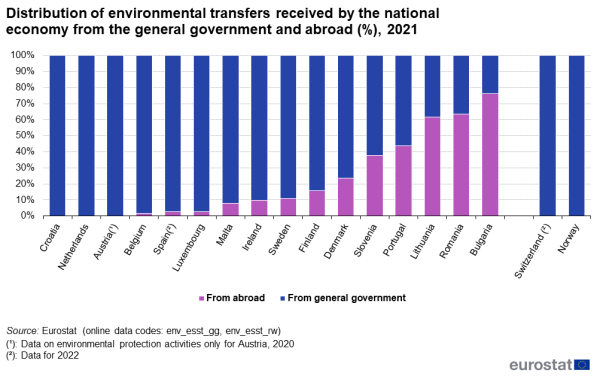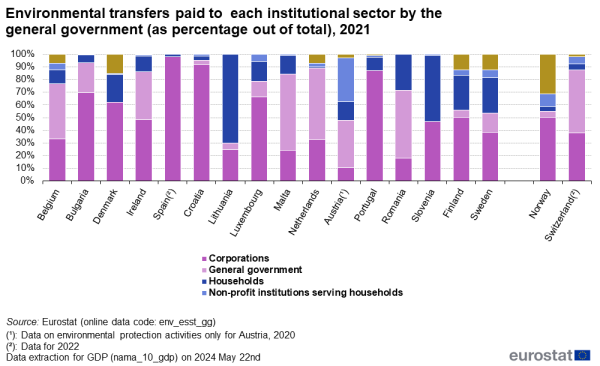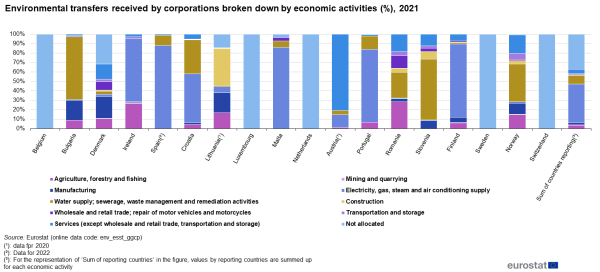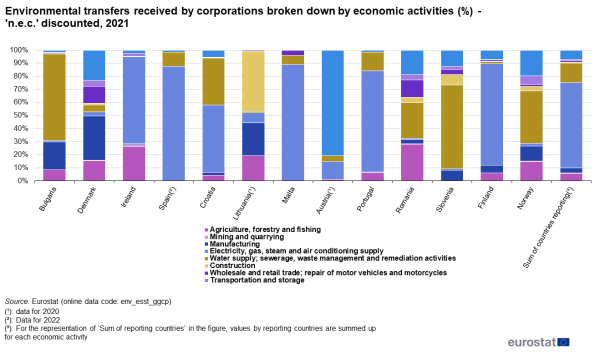Environmental subsidies and similar transfers statistics
Data extracted in May 2024
Planned article update: 30 April 2025
Highlights
In 2021, environmental transfers in the EU ranged from 0.2 % of GDP in Slovenia and Luxembourg to 1.4 % of GDP in Croatia.
In 2021, corporations, general government and households were the main recipients of environmental transfers in the EU.

Source: Eurostat (env_esst_gg), (env_esst_rw)
This article reports on subsidies and other payments whenever the purpose is to protect the environment or manage natural resources (‘environmental transfers’), such as for installing cleaner energy or for keeping nature reserves, or for research on environmental issues. The public subsidies and other payments related to the environment in EU countries ranged between 0.2 % and 1.4 % of their GDP in 2021. This article includes financing received by corporations, households, or public authorities and paid by the public administrations of the country or from abroad (including EU funds).
Full article
National environmental transfers ranged between 1.4 % and 0.2 % of GDP in 2021
For the 16 EU countries and two EFTA countries reporting 2021 data to Eurostat, environmental transfers range from 1.4 % of GDP in Croatia to 1 % in Malta and Romania, down to 0.2 % in Luxembourg, Slovenia and Norway (see Figure 1). The estimates in this article come from a Eurostat voluntary data collection and data are only available for some countries.

Source: Eurostat (env_esst_gg), (env_esst_rw)
Environmental transfers remained stable from 2018 in 2021 in almost all countries
From 2018 to 2021, environmental transfers as a percentage of GDP remained stable in almost all countries. Romania peaked at 2.9 % in 2019, but the environmental transfers as a percentage of GDP then decreased to 0.8 % in 2020 and 1 % in 2021.

Source: Eurostat (env_esst_gg), (env_esst_rw)
Environmental transfers are mainly paid by general government
In Croatia, Netherlands, Austria, Belgium, Spain, Luxembourg, Malta and Ireland, general government contributes to more than 90 % of the environmental transfers received in the country; the remaining share are incoming international flows (including EU funds). In Lithuania, Romania and Bulgaria, the contribution by other countries and the EU is larger than the contribution by general government: from 76 % in Bulgaria to slightly less than 50 % in Portugal (see Figure 3).

Source: Eurostat (env_esst_gg), (env_esst_rw)
In general, corporations, general government and households are the main recipients of the transfers paid by general government (see Figure 4). In 2021, Spain was the country where corporations received the highest share of the environmental transfers (98%). Environmental transfers from general government to other sub-sectors of general government are largest for Malta (60 %), Netherlands (57 %), Romania (54 %) and Belgium (44 %). These environmental transfers usually occur when central government provide funds to regional authorities, which further distribute these funds to final beneficiaries, e.g. programmes for financing of energetic refurbishment works to improve energy efficiency in buildings. In 2021, Lithuanian households received 70 % of the environmental transfers paid by general government. Households are also the main recipient of the transfers in Slovenia (52 %), Romania and Sweden (28 %) and Finland. These differences across countries reflect the different economic actors and policy instruments that national governments choose to use. Non-profit institutions serving households (NPISH) usually receive fewer environmental transfers than corporations and households. Environmental transfers received by NPISH in Austria in 2021 are considerably higher with 35 % compared to other countries. On average for the reporting countries, environmental transfers received by NPISH represent 4.5 % of the total environmental transfers paid by general government. Similarly, environmental transfers paid by the country governments to other countries are lower than environmental transfers to their national corporations and households. On average, environmental transfers to other countries represent 5 % of total transfers. However, environmental transfers sent to other countries represent 31 % of the total environmental transfers paid by general government in Norway and 12 % in Sweden.

Source: Eurostat (env_esst_ggcp)
Two economic activities account for most of environmental transfers paid to corporations
Environmental transfers to corporations can be further broken down by the economic activity of the corporation. Eurostat uses the statistical classification NACE Rev 2 (see Figure 5). In 2021, ‘water supply; sewerage, waste management and remediation activities’ and ‘electricity, gas, steam and air conditioning supply’ were the economic activities receiving most environmental transfers from general government transfers in most countries. Corporations operating in ‘water supply; sewerage, waste management and remediation activities’ received 66 % of the environemntal transfers from general governement in Bulgaria, 64 % in Slovenia and 40 % in Norway. Corporations operating in ‘electricity, gas, steam and air conditioning supply’ received more than 75 % of the environmental transfers from general government in Spain, Malta, Finland and Portugal. ‘Manufacturing’ and ‘services (except wholesale and retail trade, transportation and storage)’ are also frequent receivers. The economic activity ‘manufacturing’ received 23 % of environmental transfers in Denmark and 21 % in Bulgaria, while they were also significant in Lithuania (18 %). ‘Services (except wholesale and retail trade, transportation and storage)’ is not the main economic activity receiving environmental transfers in any reporting country, with the exception of Austria with 80 %.

Source: Eurostat (env_esst_ggcp)
Several countries (Belgium, Luxembourg, Netherlands, Sweden and Switzerland) report environmental transfers in the category ‘not elsewhere classified’ (n.e.c.) due to the lack of data sources. This way of reporting affects the results shown in Figure 5. When excluding amounts of the category ‘not elsewhere classified’ and recalculating the totals and shares, the new results do not alter the main findings (see Figure 6). Activities ‘water supply; sewerage, waste management and remediation activities’ and ‘electricity, gas, steam and air conditioning supply’ remain the main receivers of environmental transfers from general government (see Figure 6). ‘Agriculture, forestry and fishing’ received quite a significant amount of environemntal transfers from general government in Romania (28 %) and Ireland (26 %).

Source: Eurostat (env_esst_ggcp)
Most environmental transfers are mainly about environmental protection
Environmental transfers serve two main environmental objectives: environmental protection and/or management of natural resources (See further explanation in data sources-methodology). In 2021, most environmental transfers concern environmental protection in most of the reporting countries (see Figure 7). More than half of the environmental transfers concern environmental protection in all countries except Spain, Croatia and Denmark. Sweden, Norway and Bulgaria report the highest share of environmental transfers under environmental protection (89 %, 88 % and 87 %, respectively). By contrast, Spain and Denmark report most environmental transfers to management of natural resources (83 % and 66 %, respectively).

Source: Eurostat (env_esst_gg), (env_esst_rw)
Source data for tables and graphs
Data sources
With environmental transfers, governments finance either measures to reduce the market price of certain products (‘subsidy on product’) or other types of measures to support economic activity or consumption (‘current transfer’) or finance environmental investments (‘capital transfer’). Eurostat collects data on ‘environmental subsidies and similar transfers’ accounts (ESST) on a voluntary basis since 2017. ESST is based on Environmental-Economic Accounting 2012 Central Framework (SEEA-CF 2012) and the European System of National and Regional Accounts (SEA 2010) The concept of ‘subsidies and similar transfers’ refers to ‘transfers’ as covered in SEEA-CF 2012 § 4.136: “transactions in which one institutional unit (in this case, the government) provides a good, service or asset to another unit without receiving from the latter any good, service or asset in return as a direct counterpart”. These transfers may be classified depending on certain characteristics in: Subsidies (D.3) – SEA 2010 §4.30; Social contributions and benefits (D.6) – SEA 2010 §4.83; Other current transfers (D.7) – SEA 2010 §4.112-4.140 and Capital transfers (D.9) – SEA 2010 §4.145. Therefore, subsidies in this terminology are one specific type of transfers. Sometimes, term ‘subsidy’ is used as a synonym of ‘transfers’ or ‘subsidies and similar transfers’ (See SEEA-CF 2012 §4.137) Transfers that are part of the scope of ESST are those mentioned above that are “intended to support activities that protect the environment or reduce the use and extraction of natural resources” (SEEA-CF 2012 §4.138). The set of activities that are considered as ‘environmental’, thus included in the scope, are delineated by the classification of environmental protection activities (CEPA) and the classification of resources management activities (CReMA). CEPA is devoted to ‘environmental protection’, which refers to activities and actions which have as their main purpose the prevention, reduction and elimination of pollution and of any other degradation of the environment. CReMA is devoted to ‘resource management’, which refers to the preservation, maintenance and enhancement of the stock of natural resources and therefore the safeguarding of those resources against depletion (See SEEA-CF 2012§4.12-4.13). Environmental subsidies and similar transfers are paid by general government (S.13 as in SEA 2010 §2.111) and the rest of the world (S.2 as in SEA 2010 §2.131). Those transfers are received by institutional sectors within the economy (general government; corporations – S.11 and 12 in SEA 2010 §2.45 and 2.55; households – S.14 in SEA 2010 §2.118; and non-profit institutions serving households – S.15 in SEA 2010 §2.129) and granted to the rest of the world. In order to ease comprehension by the reader, rest of the world is also named ‘Other countries’ when referring to transfers received from abroad and ‘sent to other countries’ when referring to transfers paid to them by general government. Environmental subsidies and similar transfers paid by general government to corporations are further broken down according to activities using the NACE Rev 2 classification.
Context
The environmental subsidies and similar transfers accounts is part of the European environmental economic accounts framework. Regulation 691/2011, article 4 (pilot studies) and article 10 (report and review) refers to environmental subsidies as a candidate for a new mandatory account. Environmental subsidies and similar transfers accounts will become part of the Regulation 691/2011 by end of 2024.
Direct access to
Database
- Environment (env), see:
- Environmental subsidies and similar transfers (env_esst)
- Environmental subsidies and similar transfers from general government, by environmental activity, sector of recipient and ESA category of transfer (ENV_ESST_GG)
- Environmental subsidies and similar transfers from general government to corporations, by environmental activity, ESA category of transfer and NACE Rev. 2 activity of recipient (ENV_ESST_GGCP)
- Environmental subsidies and similar transfers from the Rest of the World to the domestic economy, by environmental activity and ESA category of transfer (ENV_ESST_RW)
Methodology
- Environmental subsidies and similar transfers - Guidelines, 2015 edition
- Environmental subsidies and similar transfers (ESMS metadata file — env_esst_esms)
Legislation
- Regulation (EU) No 691/2011 on European environmental economic accounts
- Summaries of EU legislation: European environmental economic accounts
- Commission Final 0329/2022